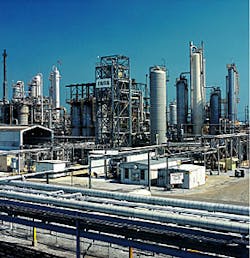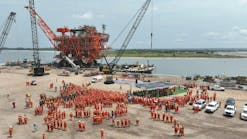One of BASF Corp.'s largest U.S. plants is its Geismar, La., chemicals complex, where a major expansion is under way. Shown here is the Geismar ethylene oxide/ethylene glycol unit. Photo courtesy of BASF AG.Germany's BASF AG has chosen North America as a target area for chemicals growth. Its expansion strategy in the region is focused on three production sites: Freeport, Tex.; Geismar, La.; and Altamira, Mexico.
U.S. subsidiary BASF Corp., Mount Olive, N.J., has long operated at the two U.S. sites, which have developed into major integrated chemical complexes. The firm is about midway through a major capital expansion at the two plants.
BASF's Altamira complex is relatively new, however. BASF Mexicana SA de CV started up the plant in 1995.
The expansion of all three of BASF's major North American sites is part of BASF AG's strategy of total integration, known as verbund-a German word that has no direct English translation. The strategy is particularly relevant in today's climate of declining oil prices and squeezed profit margins, says Carl Jennings, executive vice-president of BASF Corp. and president of the chemicals division.
"There are limits to how low oil prices can go," said Jennings, "and further gains in productivity will be increasingly difficult to achieve. Factoring in the effects of the general economic malaise around the globe, we expect a slowdown of the overall economy in the Nafta (North American Free Trade Agreement) region over the next 2-3 years."
Jennings also expects chemical industry margins to erode further, making BASF's strategy of integration and optimization essential to its future success in the region.
Mexico focus
BASF has experienced disappointing results in Mexico during much of its 12 years of operation there. This has been a result mainly of financial and political crises in the country, says Dietz Kaminski, general director of BASF Mexicana.Kaminski believes, however, that Mexico is on its way to achieving the political stability necessary to ensure economic strength.
Despite its slow start, BASF Mexicana hopes to become one of Mexico's leading chemical producers. The firm is also striving to become more of a polymer company than a colorants, chemicals, and pharmaceuticals producer, says Kaminski.
In 1997, plastics comprised 29% of BASF Mexicana's total sales of $446.5 million, while colorants and process chemicals made up 35% of sales, chemicals 20%, and the life science business 16%.
In 2000, plastics are expected to comprise 48% of BASF Mexicana's total sales of $849.8 million, while colorants and process chemicals will make up 27%, chemicals 12%, and life science products 13%.
"We plan to almost double our sales within the next 2 years...Plastics will account for the lion's share," Kaminski said. "Over half of our plastics output will be exported to the Nafta markets and to Central and South America."
He expects BASF Mexicana to be a "major contributor" to the BASF AG group of companies by 2002.
Mexico operations
The new Altamira plant has rapidly become the centerpiece of BASF Mexicana's operations. The plant's key products include:- General-purpose polystyrene, 143,000 metric tons/year.
- Acrylic dispersions, 27,000 tons/ year.
- Auxiliary products, 10,000 tons/ year.
- "Finish" products, 1,500 tons/ year.
BASF also participates in a 50-50 joint venture with Grupo Alfa. The JV, called Polioles SA de CV, operates a 35,000 ton/year expandable polystyrene plant at Altamira.
BASF says its Verbund strategy is only getting started at Altamira. The firm is building a copolymers plant in the area. Slated for start-up early in 1999, the venture will be called Americas Copolymer Enterprise (ACE).
ACE will produce acrylonitrile/ butadiene/styrene (ABS), styrene/acrylonitrile (SAN), and acrylonitrile/sty- rene/acrylate (ASA) copolymers. BASF says the 130,000 ton/year plant will be the world's largest ABS plant, with the largest rubber reactor (190 cu m). It also will be BASF's largest single investment in Latin America, at 245 million deutschemarks.
BASF is also considering adding a high-impact polystyrene plant at Altamira in 2003-04, says Alfredo Palma, BASF Mexicana vice-president and technical director. And it would like to build an ethylene unit at Altamira in the medium term, if satisfactory feedstock agreements can be reached with state firm Petroleos Mexicanos, the sole supplier of ethane feed for the country's crackers (OGJ, Sept. 28, 1998, Newsletter).
BASF is also beefing up infrastructure in the Altamira area to support its expansion plans. In addition to constructing tank farms and pipelines, it has struck a 20-year maritime terminal contract for port services with Cia. Mexicana de Terminales (CMT), which operates a major port facility at Altamira. CMT is a joint venture of Mexico's Transportaci?n Mar!tima Mexicana and Dutch firm Van Ommeren.
The terminal can handle bulk liquids ships with capacities of as much as 40,000 tons. It has one jetty and two 7,500 cu m styrene tanks, connected to the plant by an 8-km, 6-in. pipeline.
The terminal is being expanded to handle the raw material needs of the ACE copolymers plant.
BASF also is building a 10-MW cogeneration plant that will meet half the electrical requirements and all of the steam needs of the Altamira complex.
U.S. operations
BASF is in the midst of a major expansion of its two major U.S. facilities: Freeport and Geismar.The firm has invested heavily at Freeport in recent years, and will spend about $500 million more there in the next 4 years. At the end of this period, total plant capacity will be twice what it was 5 years ago, said Ravi Singhania, vice-president and general manager of the Freeport complex.
Among Freeport's products are: glacial acrylic acid, butyl acrylates, 2-ethylhexyl acrylate, 2-ethyl hexanol, neopentylglycol (sold under the trade name Neol), 1,6-hexanediol (sold as HDO), polyamide 6 resins, caprolactam, and polycaprolactam (Nylon-6).
The Verbund strategy at Freeport has resulted in process optimization measures designed to reduce the number of management layers and reduce manpower requirements. Among its achievements are:
- An increase in the employee-to-supervisor ratio to 8 from 4.
- A reduction in the number of supervisory positions to 106 from 203.
- A decrease in the number of contract companies used, to 10 from 80.
- A reduction in personnel by a total of 177 people (114 BASF employees and 63 contractors).
- Cost savings of more than $12 million/year.
Both plants are using integration measures such as producing process steam from excess heat. In addition, BASF is building a cogeneration unit at Freeport that will supply 90 MW of power starting next March.
A cogen unit and other infrastructure expansions are planned for Geismar as well.
BASF will spend more than $1 billion expanding the Geismar plant during 1998-2000, says Phil Greeson, vice-president and general manager. The plant's main products include: acetylene, aniline, urethanes, ethylene glycol, ethylene oxide, specialty amines, hydrochloric acid, 1,4-butanediol, tetrahydrofuran (THF), poly-THF, gamma butyral lactone, mono-nitrobenzene, toluene diisocyanate, methylene diphenylisocyanate, polyether polyols, n-vinyl pyrrolidone, n-methyl pyrrolidone, and polyvinyl pyrrolidone.
At Geismar, application of the Verbund strategy includes across-the-fence integration with a nearby plant operated by Borden Chemical Inc. BASF purchases formaldehyde and acetylene from Borden, and Borden buys hydrochloric acid from BASF.
Similar agreements are planned with Air Products & Chemicals Inc. and Air Liquide America Corp.
Air Products will supply dinitrotoluene, synthesis gas, and hydrogen to BASF, while BASF will supply acetylene offgas to Air Products for processing in a HyCO (hydrogen and carbon monoxide) plant that Air Products is building. And BASF sold some of its excess property at Geismar to Air Liquide, which is building an air separation plant that will supply nitrogen and oxygen to BASF.
At both the Freeport and Geismar plants, BASF's strategy is to move its production further down the chemical derivative chain, toward high-value products that enjoy greater profit margins and lower cyclicality. Examples of such products are: poly-THF, polyvinyl pyrrolidone, purified ethylene oxide, surfactants, and specialty amines.
Freeport cracker
The Verbund strategy works not only within BASF's processing complexes, but among them as well. BASF has taken the strategy a step further by building a world-scale, joint-venture ethylene complex at Port Arthur, Tex., with Fina Oil & Chemical Co.The ethylene unit will be integrated with Fina's nearby refinery (see graph, p. 32), achieving about $50 million/ year in integration benefits, according to BASF. For example, the C4 stream from the refinery's fluid catalytic cracking unit will be fractionated to remove some of the undesirable materials, then fed to the ethylene unit.
BASF and Fina chose the metathesis process for the Port Arthur cracker. The process is unique in that it converts lower-value butylene to propylene, thus producing equal amounts of ethylene and propylene.
BASF chose that route because propylene is its most-desired raw material for downstream chemicals production. BASF's cut of the propylene ouput will be transported via pipeline to Mont Belvieu, Tex., and from there to Freeport. Ethylene will be transported via pipeline to Geismar.
Upon start-up of the cracker in 2000, BASF will be long on ethylene and will sell small quantities in the merchant market. Within 5-6 years, however, all of BASF's portion of the cracker products will be consumed internally, says Jennings.
Greeson summed up BASF's integration work in its Gulf Coast facilities: "The new plants we are building (at Geismar) are key elements of BASF's Verbund strategy. The facilities will share symbiotic relationships with our existing units at Geismar, our Nafta sister plants in Freeport and Altamira, and the new steam cracker project with Fina in Port Arthur."
Copyright 1998 Oil & Gas Journal. All Rights Reserved.


